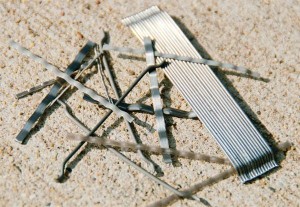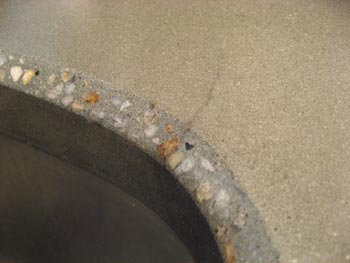Lately we’ve been talking a lot about GFRC and the alkali resistant glass fibers used in making this unique type of concrete. But, AR glass fibers aren’t the only type of fibers you can use in concrete mixes. Today I’d like to discuss some of the other types of fibers that you can use when making concrete countertops and some of their purposes. When used properly, fibers have many benefits in countertops. Fibers aren’t just for GFRC.
Fibers – Primary vs. Secondary Reinforcing
Fibers have many purposes in concrete countertops. They can be used for reinforcing (think GFRC) or can be used to prevent shrinkage and cracking. When fibers are used for structural reinforcing this is known as primary reinforcing. When they are used for shrinkage control it is known as secondary reinforcing.
Fibers can play a valuable role in both primary and secondary reinforcing. However, the type of fibers and the methods used will vary depending on which type of reinforcing you’re after. Many of the fibers listed below can provide both primary and secondary reinforcing benefits. While most fibers won’t replace steel reinforcing (like AR glass fibers do in GFRC), they can still make concrete stronger and help your concrete countertops to last longer and look better.
The Many Types of Fibers Used in Concrete Countertops
When I say there’s a lot of different fibers to choose from, I’m not kidding. In this post we’ll look at several of your options, but just briefly. I could easily create lengthy posts on the uses and benefits of each type of fiber listed here.
- Polyvinyl Alcohol (PVA) Fibers – PVA fibers have some structural strength and can also be used for shrinkage control. While they cannot replace reinforcing steel, they improve the mechanical properties of cured concrete, boosting its strength. These are the best choice when the fibers cannot show at all.
- Alkali Resistant Glass Fibers – AR glass fibers are the type of fiber primarily used with GFRC. They can also be used to provide primary and secondary reinforcing in steel reinforced concrete countertops. These fibers are special glass fibers that won’t break down, even when in contact with alkaline concrete. The alkali resistance is achieved by using zirconia. AR glass fibers come in different sizes; the ones used for GFRC are long (13 and 19mm) and large, so they will show if they’re simply mixed in to ordinary concrete. Smaller fiber bundles of AR glass are less visible, but will still show if they happen to be right on the surface.
- Polypropylene or Nylon Fibers – Polypropylene and nylon fibers are used for shrinkage control; they have no structural strength. These fibers play a valuable role during the curing process, but provide no benefit after. They simply stretch too much to provide any resistance to tensile stresses.
- Cellulose Fibers – Most of the time synthetic fibers are used for secondary reinforcement, but cellulose fibers are a naturally occurring alternative.
Some fibers are strong and can provide adequate structural strength, but the material they’re made of doesn’t make them a good choice for concrete countertops.
- Hooked Steel Fibers – Hooked steel fibers possess structural strength. They can help to distribute tensile stresses across the countertop. However they are large, ugly and will show.
- Chopped Carbon Fibers – Like hooked steel, PVA and AR glass fibers, chopped carbon fibers have stiffness and strengths equal to or greater than steel. Reinforcing is still needed, but the fibers provide a helpful boost of strength and minimize shrinkage during the curing process. But because they are black, carbon fibers will show definitely show in most concrete that’s not black or very dark.
Fibers and Shrinkage Control: How Does it Work?
Fibers thicken and stabilize the cement paste, giving it body. Fibers act like an internal three dimensional net, supporting the aggregate and minimizing settlement.
Aggregate settlement and consolidation are what drive the generation of bleedwater. For bleedwater to reach the surface, it has to form microchannels in the concrete. These microchannels form weak zones in the concrete. In addition, the walls of the microchannels can have much higher water/cement ratios than the concrete itself because of the dilution effect of the bleedwater.
All this results in weaker, more porous concrete that shows greater tendencies for cracking and shrinkage. Adding fibers boosts the properties of the concrete, mostly by preventing the detrimental effects of plastic shrinkage and bleedwater segregation.
Fibers can also help combat shrinkage by spreading the tensile loads across the concrete. Like I mentioned previously the fibers act as a net, in this case holding small cracks together and transferring stresses across cracks into adjacent concrete. This helps keep any cracks that appear small, often too small to even see. Rather than having one or two large, highly visible cracks, you’re left with a series of small, hard to see cracks spread across the slab. Cracking might be inevitable, but an almost invisible crack is always better than a big one.
One last point: the amount of fibers needed to provide good secondary reinforcement to control micro-cracks is rather low. Typical volume fraction doses range from 0.1% to 0.5%; this translates to 4 lb to 20 lbs of fibers in a cubic yard (4000 lbs) of concrete.
The fiber dose necessary to make GFRC strong is much higher. Primary reinforcing has to resist much more stress and deflection, which is why so many more fibers are needed. The typical (and minimum) GFRC volume fraction dose is 3%, equivalent to 120 lbs of fibers in a cubic yard (4000 lbs) of concrete
Creating the perfect mix for each concrete countertop requires careful consideration of the type of countertop you need to create. I hope this article has helped you to see some of the ways fibers can enhance your mix design.



